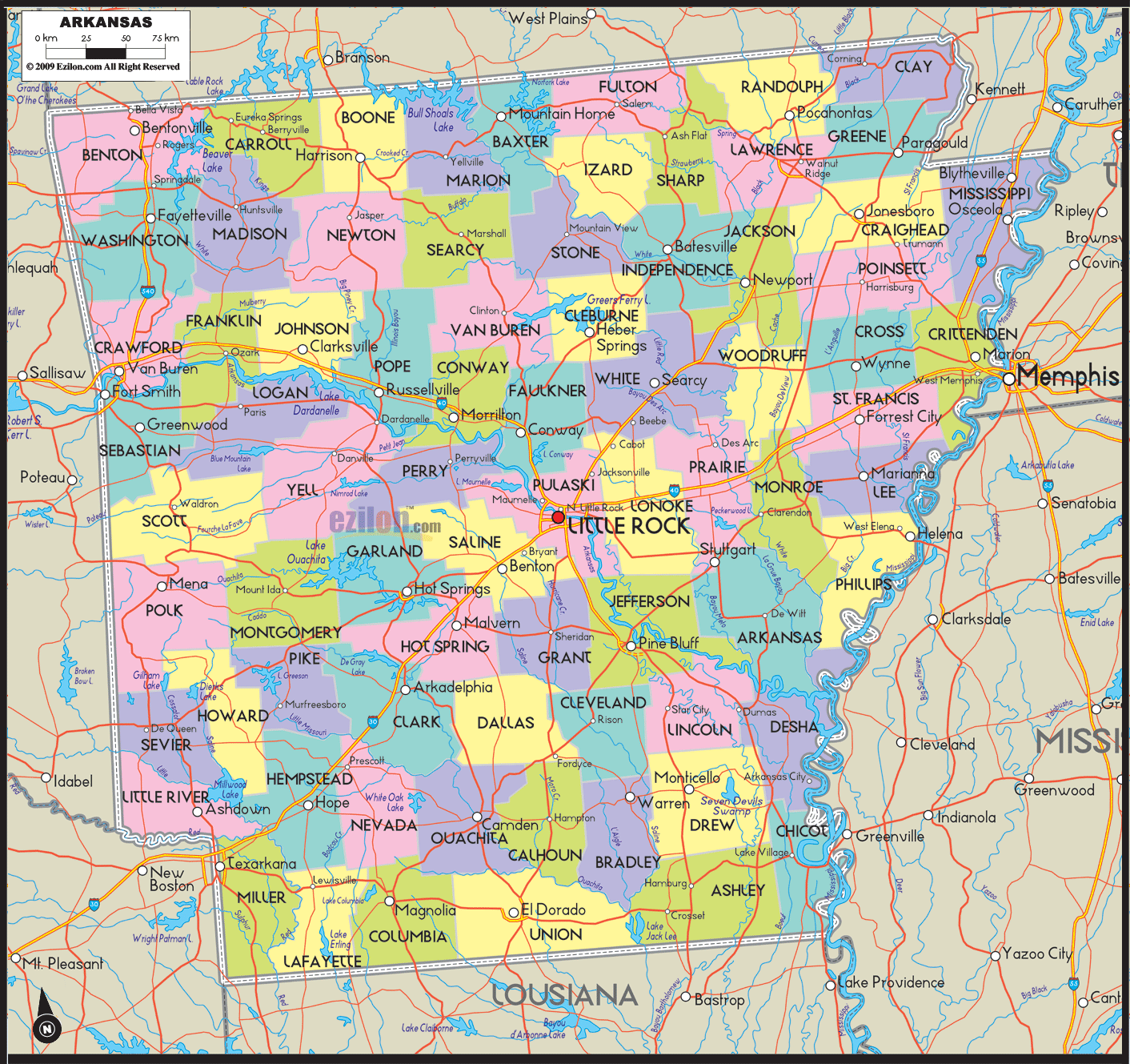

Description: Detailed large map of Arkansas showing cities, counties, towns, state boundaries, roads highway, US highways and State routes.

When one first glance at map of Arkansas cities, it may seem like an ordinary array of boundaries, a straightforward layout of names and lines. However, as one begins to peer more closely, the rich tapestry of Arkansas's landscape unfolds. This map is not just a piece of paper or a digital image; it's a living representation of this diverse state's cities, counties, and roads.
Each boundary line represents years of history and government, each county name encapsulates the characteristics of its residents, and each city marking indicates centers of economic and political activity.
Understanding this map is like taking a crash course in the political science of Arkansas. It's an indispensable tool for politicians drafting policies, students studying state governance, tourists wanting to explore every nook and cranny, and even locals searching for services or opportunities in neighboring counties.
When you transition your eyes toward the northern segment of the map, you encounter a region steeped in natural beauty and political complexity. Counties like Baxter and Boone don't just signify administrative divisions; they are the guardians of the state's northern frontier, each providing unique resources and challenges to Arkansas's governance.
Cities like Fayetteville, known for the University of Arkansas, aren't just specks on the map; they are the state's beating hearts of education and progressive thought. Roads like U.S. Route 62 aren't merely lines but critical transportation veins, enabling economic activity and communication. The northern counties, often seen as the state's gateway to the Ozarks, are marked, and their boundaries appear to almost cradle the mountainous landscapes, reminding viewers of the intricate relationship between geography and political divisions.
As your gaze moves downward, the terrain on the map subtly changes to reflect the lower-lying regions of the state's southern counties. Here, you'll find counties like Columbia and Union with different challenges and priorities compared to their northern counterparts. This region might appear quieter than the bustling centers to the north.
Still, it is a cornerstone in the state's economy, with agriculture and forestry playing vital roles - the streets and highways, including the main one known as the U.S. The significance of Route 82 lies in its ability to link even the most distant places with larger urban centers. These roads are clearly outlined on the map, offering not just direction but also a sense of interconnectedness that is crucial for the political health of the state.
Shifting your focus towards the Eastern edge of the map, you'll notice the significance of water bodies. The Mighty Mississippi is a natural boundary and a political and economic lifeline. Counties that hug the Mississippi, like Crittenden and St. Francis, are often financial gateways, serving as vital conduits for trade and transport.
Cities like West Memphis serve as economic hubs, clearly marked on the map to emphasize their political and economic importance. Highways like Interstate 40 aren't just transport routes; they are the economic arteries of the state, clearly drawn and labeled to guide the viewer's understanding of their role in Arkansas's macroeconomic stability.
The Western quadrant of the map portrays a different landscape altogether. Here, you encounter counties like Sebastian and Polk that might appear relatively remote but are crucial to Arkansas's governance's complex puzzle.
Cities like Fort Smith aren't just administrative centers but hubs of cultural and historical significance, often acting as the gatekeepers of Arkansas's rich heritage. The big roads in the United States are significant. Route 71, easily identifiable, consists of more than just black surfaces; they are symbols of the state's commitment to linking its regions together, enabling a smooth flow of goods, people, and ideas.
Last but not least, as you look at the map's central region, you'll see the true heartbeat of Arkansas, where the state's governance, economy, and culture merge. Little Rock, the state capital, is not just another city.
It serves as the venue where rulers collaborate to establish legal frameworks and regulations for the country. As such, it's marked with special symbols, perhaps a star or a larger dot, to indicate its outsized importance in the state's political landscape.
Highways like Interstates 30 and 40 crisscross this region, providing invaluable links to all other parts of the state. They serve as more than mere roads; they are the ligaments that bind the muscles of the state, ensuring that the heart (Central Arkansas) effectively communicates with the limbs (all other regions).
In wrapping up, it's evident that the political map of Arkansas is more than just lines, colors, and names. It's a vivid tapestry that intricately weaves the state's administrative, political, economic, and geographical elements into a comprehensive representation. It plays a crucial role in comprehending the functioning of the government and the interconnectedness of its distinct entities.
It reveals that Arkansas is not just a collection of isolated counties and cities but a complex, interconnected system that relies on every single one of its components to function effectively. This map is the ultimate guide for anyone who wishes to understand the depth and breadth of Arkansas's political landscape. It's an invaluable resource, a treasure trove of information that invites viewers to dive deep into what makes Arkansas a unified whole in all its complexity.
When you unfold this Detailed Road Map of Arkansas, you're not merely stretching out a piece of paper but laying out a complex and intricate network that weaves through the Natural State. The amount of detail in this road map is immense, making it a precious resource.
It will help you find your way through different areas of the state, whether traveling for work, fun, or personal exploration. The map features all major highways, state routes, and local roads that connect the state's bustling cities and quaint towns and even provide links to neighboring states. It's not just a helpful document; it's a narrative of connections, relationships, and journeys. Whether you're planning a trip to Little Rock or looking to explore the Ozark Mountains, this map will serve as your trusted guide.
When you first gaze at the upper section of this map, you can't help but notice the extensive and meticulously plotted road networks. Interstate 49, which runs north-south through the state and connects Fayetteville to the Missouri border, is prominently marked. The highway is a vital economic and social artery for the region, linking small towns and natural landmarks, such as the Ozark National Forest and the Boston Mountains.
Also notable in the northern region are U.S. Routes 62 and 412, meandering their way through the rugged terrains and linking cities like Eureka Springs and Harrison. These roads are clearly labeled, delineating their paths across county borders and through state parks, serving as both a guide and a geographical narrative of the land they traverse.
If you're looking for a scenic byway to explore, Highway 7 cuts through the northern part of the state from Harrison to Hot Springs, offering unparalleled views of the Ozarks and Ouachitas.
The southern part of the state offers its own unique road map features. Interstate 30 stands out, shooting east-west and serving as a primary connector between Texarkana and Little Rock. It's a crucial interstate for local travel and those traversing the country, linking Arkansas to Texas and Tennessee.
Additionally, U.S. Route 82 meanders through the southern part of the state, passing through cities like El Dorado and Magnolia and offering a more leisurely route than the interstate. This road provides valuable context on the map, showing how more minor towns connect to the more significant economic hubs in the state.
As your eyes move to the eastern edge of the map, you'll find U.S. Route 65 as a critical feature. This major north-south route is vital for connecting the Delta region to the rest of the state, passing through cities like Pine Bluff and Helena-West Helena. Near the northeastern corner, Interstates 55 and 40 are critical links to Tennessee and beyond, extending Arkansas's reach to the larger southeastern and midwestern United States.
Western Arkansas boasts its own set of critical roads. U.S. Route 71 and Interstate 40 are standout features, connecting Fort Smith to Fayetteville and providing a crucial north-south corridor for travel. The map offers an intricate view of how these roads integrate with local routes, helping to paint a picture of the complex, interconnected road network that binds the state.
Central Arkansas, the state's hub, features a dense network of roads converging around Little Rock. Interstate 40, Interstate 30, and U.S. Route 67/167 intersect, making the area a pivotal crossroads for the state and the region. The map marks these routes, offering context for their role in connecting Arkansas's capital to the rest of the state and beyond.
Arkansas's connectivity to its neighbors is an essential feature of the map. From the north, U.S. Route 63 and Interstate 55 connect Arkansas to Missouri. In the east, Interstates 40 and 55 provide critical links to Tennessee. To the south, you'll find U.S. Routes 71 and 59, which lead into Louisiana and Texas. These routes are marked, underlining the state's interconnectedness with the broader United States.
In summary, this Detailed Road Map of Arkansas is an indispensable tool for anyone navigating the Natural State's varied geography and social landscapes. Whether planning a trip, driving through, or just curious about the state's infrastructure, this map offers a detailed, thorough guide to help you.
From the main interstates that serve as the state's thoroughfares to the more minor roads that stitch together its rural communities, every route serves as a lifeline, and this map captures that intricate web in exceptional detail.

Physical Map of Arkansas
Physical map and map image of Arkansas.

Geographical Map of Arkansas
Geographical map and map image of Arkansas.

Regional Directory of United States of America
Information and guide about United States of America and websites with American topics.

Regional Directory of Europe
Information and guide about Europe and websites with European topics.

Regional Directory of Australia
Information and guide about Australia and websites with Australian topics.